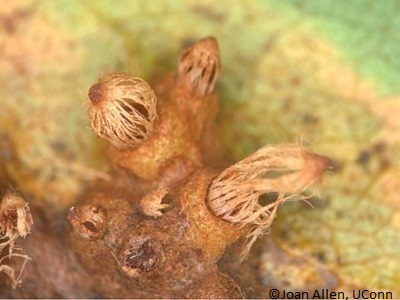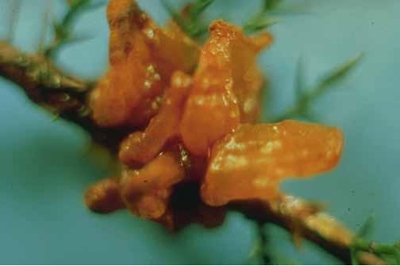Gymnosporangium sabinae
Background
Pear trellis rust is a new disease for Connecticut in 2012. It is caused by the rust fungus Gymnosporangium sabinae. The disease is common in Europe and has been present in parts of Canada (British Columbia) since the 1960s and the Pacific Northwest since the late 1990s. It was reported in Ontario in 2007 and in Michigan for the first time in 2009. In 2011, pear trellis rust was confirmed in southeastern New York state. The disease can cause losses in pear crops and impact the health of ornamental pear trees.
Host Plants
This rust fungus has a complex life cycle involving two unrelated groups of hosts. Susceptible hosts include both ornamental (Pyrus calleryana) and orchard (Pyrus communis) pear trees and many species of juniper (Juniperus sp.).
Symptoms & Signs
Symptoms on pear begin as yellowish-orange leaf spots (Figure 1) early in the season. Young fruit and twigs can also be infected. Leaf spots can become bright reddish orange during the summer. By mid-summer, tiny black dots (pycnia) appear in the center of the leaf spots (Figure 1). These do not produce infectious spores but play a role in the development of spore structures later in the season on the lower leaf surface. By late summer, brown, blister-like swellings form on the lower leaf surface just beneath the leaf spots. This is followed by the development of acorn-shaped structures (aecia) with open, trellis-like sides that give this disease its common name (Figure 2). Aeciospores produced within the aecia are wind-blown to susceptible juniper hosts where they can cause infections on young shoots. These spores are released from late summer until leaf drop.


On juniper, shoot infection results in a spindle shaped gall. In the second spring after infection, orange gelatinous masses of spores are produced during wet weather (Figure 3). These spores are wind-blown and infect expanding pear leaves, young fruit, and shoots. Galls will produce spores for several years unlike the galls of the closely related cedar-apple rust which only produce spores for one season. The spores can be wind-blown for distances up to about three to four miles. Juniper health is not usually severely impacted by this disease.

Both pear and juniper hosts are required for this pathogen to complete its life cycle. The fungus may also overwinter in twig or branch galls on pear hosts that can serve as a source of new pear infections the following spring.
Management
- Separate pear and juniper hosts by as much distance as possible. Separation distance recommendations range from 100 to 1000 feet. The more you can eliminate the second host from the area, the more you will reduce the amount of disease.
- For protection of pear, galls can be pruned from juniper hosts before April 1st. This can be difficult if there are many junipers.
- The galls are also inconspicuous and hard to find when they are not producing their orange spore masses.
- When adding juniper to a landscape that includes pear trees, plant resistant juniper species. These include Juniperus squamata, J. communis, and J. horizontalis.
- Remove infected pear leaves, fruit and twigs by mid-August. This will not be practical on large or heavily infected trees.
- Fungicides are not currently labeled specifically for this disease. Those labeled for control of other Gymnosporangium rusts on pear may offer some protection.
- For a list of recommended fungicides see the Connecticut Agricultural Experiment Station fact sheet Gymnosporangium Rusts or call the UConn Home & Garden Education Center at 877-486-6271.
- When using pesticides, always read and follow the label directions carefully.
Written by J. Allen, UConn Home and Garden Education Center, October 2012